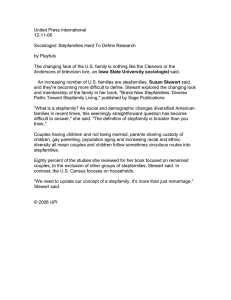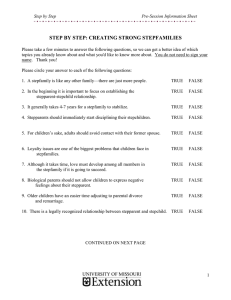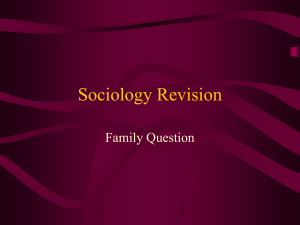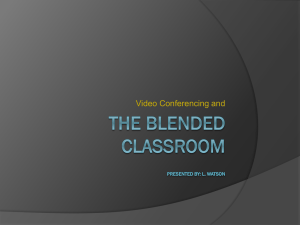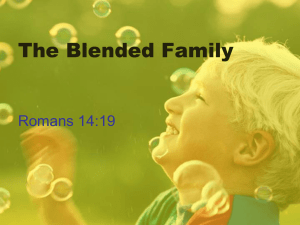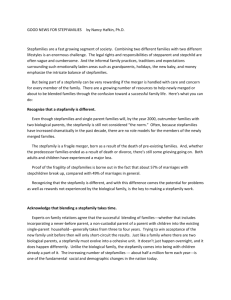The Complex Dynamics of Blended Families
advertisement
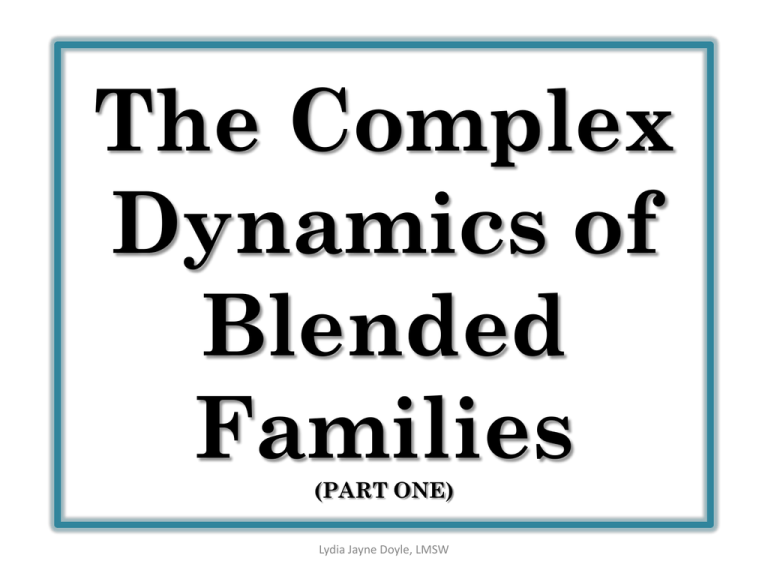
The Complex Dynamics of Blended Families (PART ONE) Lydia Jayne Doyle, LMSW Definition of Blended Families The blended family is the modern term for Stepfamily. As our society has changed so has the traditional image of stepfamilies. Today stepfamilies can include multiple children from several previous marriages and relationships. Societal changes, new biological changes, shifts in marital expectations, all have lead to a wide variety of family forms (Visher). The Pew Research Center released a national report in 2012 giving the following statistics on blended families. • 42% of all American Adults have some kind of stepfamily relationship, that is 95.5 million adults. • 13% of adults are stepparents with males leading females in the overall percentage. • 1/3 of all American children are expected to live in a stepfamily before age 18. According to the 2011 U.S. Census the 52-62% of all first marriages end in divorce, with 75% of those divorced persons remarrying (U.S. Census 2011) • Data varies from study to study on the numbers of remarried and successful remarried families. • According to Marriage Foundation (2013) new research reports 2nd marriages are not more likely than first to end in divorce. • Studies did report there is a need for therapist who have the ability to counsel blended family couples and children of blended families (Good Therapy) There are differences and similarities between first and second marriages. 1. Remarried individuals tend to be older. 2. In most 2nd marriages at least one of the individuals has a child from previous relationship. 3. First marriages don’t have a social stigma of 2nd marriages. 4. 2nd marriages have more financial obligations. 5. 2nd marriages have more emotional baggage. 6. 1st marriages has less responsibilities. 7. 2nd marriages have more disagreements. Second marriages have very complex dynamics. NEW COUPLE EXPARTNER & EXPARTNER & CHILDREN CHILDRE N AUXILLARY FAMILY • The continued involvement of former spouses and family members complicates the blended families ability to integrate. • The ongoing relationship with previous partners, either in terms of closeness or conflict has a profound effect on new family. Dynamics of Stepfamily living • Cultural Concept of step family livingdevaluing of stepfamily in society. • Paths to Stepfamilies 1. Divorce-loss-parenting or lack of parentingloyalty conflicts-guilt 2. Death-bereavment-loss-loyalty 3. Never married-legal concerns-respect issues Differences Between 1st Families and Stepfamilies • • • • The family begins after loss or change No shared family history There is less loyalty All parties have expectations from previous families • Children can be members of two or more households. Which causes children to have multiple parenting figures. • Step-parents do not have a legal relationship with stepchildren. • There is a long integration period-the age a child is at time of stepfamily inception, it will take that many years for the child to accept the step-parent. • The household experiences intense unexpected emotional changes • Ambiguous family boundaries • Ambiguous roles • Stepfamilies have overall more stress Generally, there is more complexity, more ambiguous boundaries, and more ambiguous roles, less cohesiveness, more loss, and more division (www.stepfamily.org) The Stepfamily Structure 1. 2. 3. 4. 5. 6. Stepparent-outsiders Residential stepmother/residential stepfather-are often caught between their partner and the children. Stepfathers fare better than stepmothers. Non-residential stepmother/non-residential stepfather-often distant and uninvolved. Remarried parent/non-remarried parent-jealously, feeling of inadequacy, insecurity. Children/step-siblings/half-siblings-anxiety, fear of unknown, unable to cope with loss, less nurture from parent and affection, more overall child abuse. Half-siblings integration is dependant on older children’s acceptance of new child and frequency of contact with the new child. Step-siblings often struggle for affection and financial resources. All tend to have more behavior issues, school issues. Grandparents-Can be instrumental in building the bridge for families or instrumental in destroying the family and affecting adults and children Later generations. 7. Auxiliary Family-Aunts/Uncles/Cousins Can have positive influences or very destructive negative influences on families. The negative influences by outsiders projected to the new family have a greater impact to influence integration. Stages of Integration 1. Fantasy Stage-Couple is “in Love”, children are hopeful 2. Immersed Stage-Family is attempting to assimilate to a nuclear family mold. 3. Awareness Stage-This is hard, changes might need to occur, family splits along bio-lines, remarried spouse caught in middle. 4. Mobilization Stage-Step-parent starts to be accepted into family. 5. Action Stage-Occurs 3-4 years after couple inception. Boundary around couple is developed and is accepted. Ex-spouses and new spouses are more accepting of each other. Children still do not quite there. 6. Contact Stage-Step-parent is no longer an outsider. 7. Resolution Stage-Acceptance of family, cooperation between homes. Elements of Successful Blended Families 1. 2. 3. 4. 5. 6. 7. Realistic expectations Focus is on couple Children feel safe Family rituals Household boundaries with flexibility Intentional development of step relationships Step-parent does not compete with bioparents 8. Step-parents discipline less and have less responsibility for step-children 9. Spend more “one on one” time with individuals of family 10. Auxiliary Family members have strict boundaries and are not allowed to have as much influences on family integration. Part II • Types of Therapies used to Counsel Blended Families • Initial Assessments • Developing a Foundation • Facilitating Stepfamily Integration References References Resources
